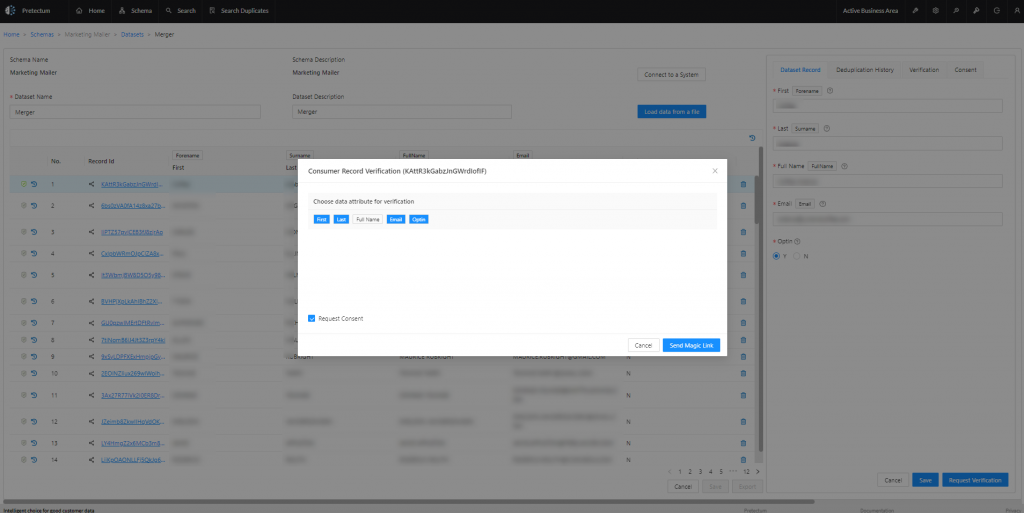Introduction
Customer Master Data Management (CMDM), when undertaken as a business activity with or without a CMDM like the Pretectum CMDM presents many data management obligations to even the most average of organizations. New rules of data privacy, consumer mistrust, government action, competition for customers and the value of consumer data for businesses, consumers’ own views on data collection, regulations, tools for data control, security practices, and the integration of tooling with Consent Management Platforms (CMP) or inherent support thereof are all factors that require some consideration.
New Rules for Data Privacy
Data privacy has undergone a profound transformation in recent years. Gone are the days when businesses could amass and exploit customer data with impunity. The emergence of stringent data protection laws, in many countries and regions, has ushered in a new era around policies and procedures for customer data management. These regulations compel organizations to respect individuals’ privacy, requiring explicit consent for data collection, and imposing heavy fines for non-compliance. This shift underscores the importance of consent management in CMDM, as organizations must adapt to these new rules or face severe consequences.
Consumer trust is the foundation of any successful business relationship. However, in the wake of high-profile data breaches, surveillance scandals, and unethical data practices, consumers are increasingly wary of sharing their personal information. This mistrust poses a significant challenge for those engaged in CMDM, as obtaining and maintaining consent becomes more complex. Consumers demand transparency, control, and assurance that their data will be handled responsibly. Organizations must work diligently to regain and maintain this trust, emphasizing robust consent management practices to mitigate the impact of consumer mistrust on data privacy.
Governments worldwide are also taking proactive steps to protect citizen data privacy. The European Union’s GDPR serves as a global benchmark for data protection laws, while many countries are enacting similar legislation or strengthening existing regulations. This government action has far-reaching implications for CMDM, as organizations must navigate a complex landscape of diverse privacy requirements. Compliance with these regulations is not optional but mandatory, necessitating the integration of consent management into CMDM strategies to ensure alignment with evolving legal standards.
Competing for Customers
Organizations are all vying for customers’ attention and loyalty; personalized marketing strategies depend on comprehensive customer data, making data privacy a pivotal factor in the race for customer acquisition and retention. While data-driven insights are invaluable for crafting tailored offerings, organizations must strike a delicate balance between data utilization and respecting customer privacy. The CMDM layer becomes the battleground where organizations demonstrate commitment to data protection and making consent management a strategic imperative is essential to gain a competitive edge.
Data fuels customer engagement, informs strategic decisions, and enables the development of innovative products and services. In the CMDM layer, customer data takes center stage, driving operational efficiency and enhancing customer experiences. However, this data’s value is directly tied to the consent sought and obtained and the associated trust that consumers place in the organization. By using consent management effectively, businesses can unlock the full potential of consumer data while respecting privacy boundaries.
Consumer sentiments play an important role in shaping data privacy practices within the use practice of CMDM. Public awareness of data breaches, hacking incidents, and unauthorized data collection has elevated their awareness and potential concerns about data security. Consumers are increasingly vocal about their expectations regarding the protection of their data, and they demand accountability from organizations on data holding and handling. CMDM practice must incorporate these evolving consumer views into the management approach, placing a premium on consent management and robust security measures.
Tooling that Controls
As consumers become increasingly aware of their data rights, they expect tooling that empowers them to exert more control over their personal information. Consent management in the platforms, designed specifically to address this, is needed, providing individuals with mechanisms to grant or revoke consent, specify data usage preferences, and monitor how their data is being utilized. Integrating such tools into CMDM practices not only enhances compliance but also fosters trust and goodwill among consumers.
Security breaches can have devastating consequences, eroding consumer trust and tarnishing an organization’s reputation. The CMDM layer is a prime target for cyberattacks due to its wealth of sensitive customer data. Therefore, robust security practices are integral to CMDM’s success. The effective fusion of consent management with stringent security measures not only safeguards data but also reassures consumers that their information is in safe hands, bolstering trust and loyalty.
Combining a Customer Data Platform (CDP) with a Consent Management Platform to Manage Customer Data While Respecting Privacy Laws and Collecting User Consent
The integration of a Customer Data Platform (CDP) with a Consent Management Platform (CMP) represents a powerful synergy in the realm of CMDM. A CDP enables organizations to collect, unify, and activate customer data for various purposes, from marketing to customer service. Simultaneously, a CMP ensures that this data is collected and used in compliance with privacy laws, obtaining explicit consent and respecting individuals’ preferences.
This combination creates a dynamic CMDM framework that is not only data-driven but also privacy-conscious. By leveraging the strengths of both functionalities, organizations can deliver personalized experiences to customers while demonstrating a commitment to data privacy and consent management. Moreover, this integration streamlines the complex task of managing and tracking consent across multiple touchpoints, simplifying compliance efforts.
In the CMDM landscape, consent management and data privacy are integral components that cannot be ignored. The evolving rules of data privacy, consumer mistrust, government regulations, competitive pressures, and the immense value of consumer data necessitate a holistic approach to CMDM that has consent management at its core is most valuable.
By adopting robust consent management practices, and leveraging the power of a CMDM with consent management accompanied by stringent security controls and data quality measures, organizations can navigate the complex terrain of CMDM while respecting individuals’ privacy rights. In doing so, they can not only meet legal requirements but also build and maintain the trust of customers in an era where data privacy is paramount.







